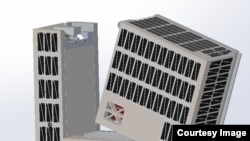If all goes as planned, a group of U.S. university students will have placed a satellite powered exclusively by water, into orbit around the moon in just over a year.
The Cornell University team CisLunar Explorers (cislunar means "between Earth and the moon") and their eponymously named satellite - actually two adjoining satellites - are taking part in a NASA program called the Cube Quest Challenge.
Cube Quest
The challenge is simple: design, build and deliver "flight-qualified, small satellites capable of advanced operations near and beyond the moon."
Nothing to it, right? Evidently not, because there are 10 teams that are competing in the challenge with names like "Cubequestador" and "Eagles Quest."
But the CisLunar Explorer satellites are unique because the only form of propulsion on board these these two small (30 centimeters or so) L-shaped craft is water.
The idea is the brainchild of Mason Peck who works at Cornell University but used to be NASA's chief technologist. He has always wanted to figure out a way to get beyond rockets as a way to push our spacecraft beyond earth.
“A lot of the mass we send into orbit these days is in the form of rockets – the only way we get anything into space,” he said in a Cornell press release. “But what if we could use what’s already there? If we could do that, if we could refuel spacecraft while they’re already in space..."
Here's how it works: The craft is two connected satellites that will gradually separate from each other, both shaped like the English letter "L." Water is stored in the lower part of the L . Energy from the sun will electrolyze the water into its two parts, hydrogen and oxygen. Put the hydrogen, oxygen and a spark together and you get a bang that provides thrust, with water as the only by-product.
And it turns out water is pretty plentiful out in space. Icy comets are full of it, and NASA is currently in the process of looking for it on a number of rocky near-earth asteroids. The newest theories suggest that most of the water on our planet may have come from asteroids or comets when the ancient Earth was being bombarded with space junk in its formative years.
CisLunar Navigation
Another cool thing about the CisLunar Explorer is how the team is teaching it to navigate its way through space.
The idea is to copy how ancient mariners used the moon, sun and stars to fix their position on the oceans.
Once the twin satellite halves separate after launch they will spin around each other on their way to the moon to keep them from going off course. They will be equipped with cameras and be constantly taking pictures of the sun, Earth and the moon, and comparing their positions and their size.
Based on where the sun, moon and Earth are at any given moment, the CisLunar Explorers will do the math to figure out their position.
"‘Okay, I must be here, because these bodies look like this,’” is how Cornell engineer Kyle Doyle explains it. “It’s very much like ancient explorers using the sun and moon to navigate."
And the Winner is?
Of the 10 teams competing, the top three winners will hitch a ride on board NASA's space launch system in early 2018. The competition is in four stages and the Cornell team has been in the top three in stages one and two. The winners of this third stage will be announced in about a month, and the final three winners will be announced in early 2017.









